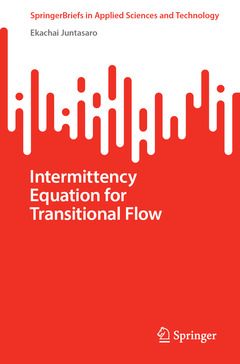Intermittency Equation for Transitional Flow, 1st ed. 2022 SpringerBriefs in Applied Sciences and Technology Series
Auteur : Juntasaro Ekachai

This book provides the intermittency equation that is derived a priori. Since the intermittency equation is mathematically obtained, the resulting gamma transition model no longer requires any extra parameters and terms to explicitly account for free-stream turbulence and pressure gradient like the previous transition models.
Instead, the present gamma transition model can naturally predict natural transition and effects of free-stream turbulence and pressure gradient on the transition process. Furthermore, the present gamma transition model requires much fewer model constants than the previous transition models.
The book is beneficial for CFD researchers in industry and academia who confront modern complex applications involving simultaneously laminar, transitional and turbulent flow regimes, and ideally relevant to graduate students in applied physics, applied mathematics and engineering who are interested in the world of laminar-to-turbulent transition modeling in CFD, or would like to further advance more realistic transition models in the future.Chapter 1. Introduction.- Chapter 2. Derivation of Intermittency Equation.- Chapter 3. Modeling Concept and Formulation.- Chapter 4. Model Constant Calibration.- Chapter 5. Model Validation.- Chapter 6. Application Test Case.
Ekachai Juntasaro received B.Eng. degree in mechanical engineering from King Mongkut's Institute of Technology Ladkrabang (KMITL), Thailand, in 1989, and pursued both M.Sc.and Ph.D. degrees in mechanical engineering at Imperial College London, U.K., in 1992 and 1997 respectively with the Royal Thai Government Scholarship. His M.Sc. and Ph.D. theses were under supervision of Dr. Mike M. Gibson who was one of the notable contributors in turbulence modeling. In 1997, he started working as Lecturer at School of Mechanical Engineering, Institute of Engineering, Suranaree University of Technology (SUT), Nakhon Ratchasima, Thailand, where he became Assistant Professor and AssociateProfessor in 2001 and 2006 respectively. Since 2008, he has worked as Associate Professor in Mechanical Engineering Simulation and Design (MESD) Group at The Sirindhorn International Thai-German Graduate School of Engineering (TGGS), King Mongkut's University of Technology North Bangkok (KMUTNB), Thailand. His research interests are transition and turbulence modeling with/without analytical wall function (AWF), unstructured finite volume method for computational fluid dynamics (CFD), microfluidics, and turbomachinery flow in power plants.
Provides a comprehensive review of transition models
Demonstrates the derivation of the intermittency equation step by step in detail
Explains how to control the base turbulence model with the intermittency
Date de parution : 05-2022
Ouvrage de 84 p.
15.5x23.5 cm
Disponible chez l'éditeur (délai d'approvisionnement : 15 jours).
Prix indicatif 52,74 €
Ajouter au panier


